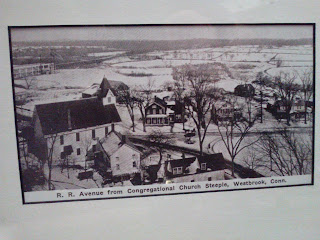My wife Roberta and I spent some of Saturday morning at the Westbrook Historical Society's museum - prompted by a special, personal invitation by my Mom.
We got to meet and talk with Cathy Doane, as well as Gary Bazzano who maintains a great website about Grove Point Beach.
Just as the label says, these came from...
...also known as Hawk's Nest and also thought to possibly be Obed's Hammock.
The Gages write about it here:
and here:
www.stonestructures.org/Pilots-Point-Site.pdf
At another location, a large boulder is (or was - I've haven't been there yet and hope it isn't gone) known as Obed's Sacrifice Rock (or "Altar") appears to have been a Tobacco Sacrifice Stone.
"Histories of the Saybrook, CT area include mention of Obed and "Obed's Sacrifice Rock." Obed appears to have been a "son of a Hammonassett Chief; and after the subjugation of the Pequot, a servant to Gov. Fenwick: that Fenwick did give him...two acres more or less near the confluences of Pychaug & Menunketezuck rivers, known as Obed's Homake."
He later lived near Springbrook Rd, "passing most of his time in the retirement of his wigwam or the solitude of the chase." Obed's Sacrifice Rock was a boulder "contiguous" to his "aboriginal structure." The author continues to write in a language somewhat similar to American English, "Upon this symbol of pristine faith, was kindled from time to time, a fire which consumed the sacrifices tendered, with sweet incense from bay and birch; mingled with the fumes of tobacco." {http://wakinguponturtleisland.blogspot.com/2008/08/moms-back-yard.html}
Obed's Altar was a "large flat rock:"
The first Stone Concentration I ever became positive was an animal effigy, a life-sized Bear's Head (that will rock when put into motion) was another Tobacco Stone that included a fire starting stone:
It was nice to be talking with people who not only collect old photos, but have also tried to locate where the photos were taken. There's some beautiful old landscapes where one wonders just what might be contained in those "stone walls" or possibly already existing Native American-made Stone Rows that were put into use as "animal commons:"
This year (1639), the common land was divided into
the"ox common," "cow common," and "calf
common." The sheep and goats, of which
there were many, had prescribed limits.
Each flock was the charge of a keeper, who
was obliged to fold them at night to
protect them from the wolves. In 1642, it
was estimated that there were twelve thou-
sand cattle and three thousand sheep in
Town. Many of these grazed on the Hill.
Originally, the livestock was imported from
Holland."
And of course there's this famous Turtle:
















No comments:
Post a Comment